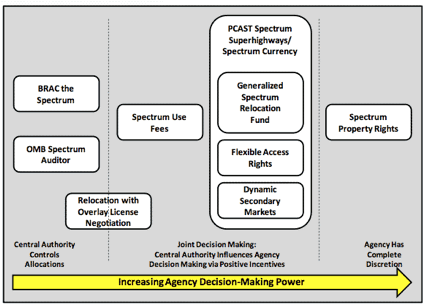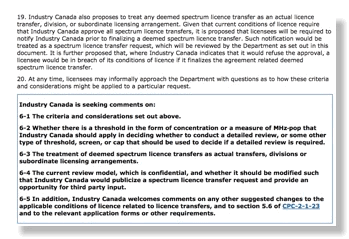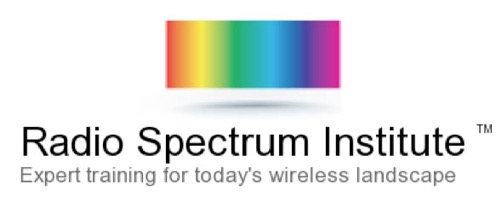How Many Questions in FCC NOIs/NPRM?
"Let me count the ways"
How do I love thee? Let me count the ways.
I love thee to the depth and breadth and height
My soul can reach, when feeling out of sight
For the ends of being and ideal grace.
I love thee to the level of every day's
Most quiet need, by sun and candle-light.
I love thee freely, as men strive for right.
I love thee purely, as they turn from praise.
I love thee with the passion put to use
In my old griefs, and with my childhood's faith.
I love thee with a love I seemed to lose
With my lost saints. I love thee with the breath,
Smiles, tears, of all my life; and, if God choose,
I shall but love thee better after death.
Elizabeth Barrett Browning - Sonnet 43
In February we talked here about the FCC Process Reform Report and its many helpful proposals for FCC reform. We filed comments at FCC on some of these issues. The final report based on comments received is still pending.
In our comments we discussed, among other things, Recommendation 3.12: “Consider Listing Specific Questions with Rebuttable Presumptions at the End of an NPRM”. We said that FCC NOIs and NPRMs have an excessive number of poorly organized comments and showed how FCC’s UK and Canadian counterparts organized the questions in their counterparts to NOIs and MPRMs much better.
Segment of Industry Canada Consultation
In an ex parte filing this week we expanded on our original comments on the Process reform Report, focusing on the issue of questions in NOIs and NPRMs. Here is a key table from the filing:

While the 2 agenda items analyzed were issued under different FCC leadership, they were each high visibility and high priority items when released. The excessive number of questions is not the only issue. In both documents questions are in all sorts of places and are badly organized. Based on my experience a decade ago in the “sausage factory”, I suspect that questions grow during the drafting process as various staffers and 8th Floor offices look at drafts. The easiest way to get someone to sign off is to add another question to show you are concerned and listening. Thus questions grow out of control with no central accountability for the end product.
This tangled question structure then impacts everyone involved:
- Commenters have to spend time sorting the questions and figuring which to respond to. After all can you really respond to 200+ questions in the allotted time. Perhaps some commenters group the questions one way and others group them a different way.
- In the reply comment phase, the problem gets worse as one has to sort through how various other parties dealt with the mass of tangled questions.
- Finally the poor FCC staff that does comment summaries has to find a way to organize this mess. This takes extra time and slows down process. Indeed even though Docket 09-157 was a high priority processing when adopted, it has had no further action in nearly 5 years!
Readers who are concerned with the mess resulting from tangled webs of questions in FCC NOIs/NPRMs might wish to support this issue in statements in the Process Reform proceeding.
Better to light a candle than curse the darkness
Correction: NTIA/ITS Measurements 225-400 MHz
For example here are several recent NTIA occupancy measurement reports that include 225-400 MHz data:
- NTIA Technical Report TR-14-502: Broadband Spectrum Survey in the Chicago, Illinois, Area - Data taken in September 2012 and published in April 2014.
- NTIA Technical Report TR-13-496: Broadband Spectrum Survey in the Denver Area - Data taken in June 2011 and published in August 2013
- NTIA Technical Report TR-14-498: Broadband Spectrum Survey in the San Diego, California, Area - Data taken in May and June 2012 and published in November 2013
In addition, while many previous NTIA/ITS reports did not include 225-400 MHz, these 2 did:
- NTIA Technical Report TR-95-321: Broadband spectrum survey at Denver, Colorado - Data taken in September and October of 1993 and published in September 1995
- NTIA Technical Report TR-97-334: Broadband spectrum survey at San Diego, California - Data taken in September and October of 1993 and published in December 1996.
We apologize to NTIA and our readers for presenting information that was not correct and not noticing the change in late 2013 in this area. We are correcting all the past posts that discuss this issue to include a link to this correction.
Comments on House Spectrum White Paper

Your blogger filed comments yesterday on the House Energy & Commerce Committee’s spectrum white paper.
The comments focused on FCC and NTIA reforms that might be accomplished with little or no new legislation - a likely necessity given our dysfunctional Congress now. They explained that not only is FCC slow in authorizing even noncontroversial new technology, it is slow in dealing with interference problems of major industries that need rulemaking action to resolve. They raise the hypothesis that FCC implicitly or explicitly tells even powerful regulatees that its spectrum policy resources are limited so they have to choose between getting new spectrum or getting help cleaning up existing spectrum. Shouldn’t FCC be able to do both?
But FCC probably can’t do both as long as it has only one job stream focused on the 8th Floor. Under Section 5 of the Communications Act FCC has great power to delegate authority to employees or boards of employees - as it did with the former Review Board.
The comments also raise the issue of Section 7 of the Communications Act and the 30 yeas that FCC has ignored it.
Spectrum Job Open at NTIA

Job Title: Telecommunications Policy Specialist (DEU) (Spectrum Clearing)
Department: Department Of Commerce
Agency: National Telecommunications and Information Administration
Job Announcement Number: NTIA-FRNA-2014-0069
| SALARY RANGE: | $89,924.00 to $138,136.00 / Per Year | ||
| OPEN PERIOD: | Wednesday, April 16, 2014 to Wednesday, April 23, 2014 | ||
| SERIES & GRADE: | GS-0301-13/14 | ||
| POSITION INFORMATION: | Career or Career Conditional - Full Time/Permanent | ||
| PROMOTION POTENTIAL: 14 | DUTY LOCATIONS: | 1 vacancy in the following location: Washington DC, DC | |
| WHO MAY APPLY: | All qualified U.S. citizens | ||
| SECURITY CLEARANCE: | Secret | ||
| SUPERVISORY STATUS: | No | ||
This position is currently located in Washington D.C. but will relocate to Reston, VA in the near future. This position is also being announced concurrently under Merit Assignment Procedures (MAP) vacancy number: NTIA-FRNA-2014-0068. Applicants who wish to be considered under MAP must apply to both vacancies separately. This position is located in the U.S. Department of Commerce (DOC), National Telecommunications and Information Administration (NTIA), First Responder Network Authority (FirstNet). FirstNet is a new independent authority within NTIA that will be responsible to design, build, deploy, operate, and maintain a nationwide, interoperable public safety broadband network pursuant to Title VI of the Middle Class Tax Relief and Job Creation Act of 2012, Pub. L. No. 112-96 (the Act). FirstNet holds a single, public safety wireless license of 22 megahertz (MHz) of spectrum between the frequencies of 758-769 MHz and 788-799 MHz.
The specialist in this position will report to the Director of Regulatory Strategy of FirstNet and will be responsible for performing complex assignments concerning the extensive range of spectrum issues for FirstNet. The position will perform work with a high degree of transparency and include the FirstNet leadership in the work being done.
For details surf over to https://www.usajobs.gov/GetJob/ViewDetails/367394100
UPDATE
Here are some jobs now open in spectrum policy at FCC also:
(This is actually an unusually large number of such openings at the same time.)
Electronics Engineer
This position is located in the Office of Engineering and Technology, Laboratory Division in Columbia, MD. THIS ANNOUNCEMENT HAS BEEN AMENDED TO EXTEND THE CLOSING DATE TO 4/28/14 FROM 4/21/14.
| Salary: | $106,263.00 - $157,100.00 / Per Year |
| Series & Grade: | GS-0855-14/15 |
| Location(s): | Columbia, Maryland |
| Open Period: | 4/7/2014 to 4/28/2014 |
| Announcement Number: | DEU-OET-2014-002 |
Electronics Engineer
This position is located in the International Bureau, Strategic Analysis and Negotiations Division, Cross Border Negotiations and Treaty Compliance Branch. Relocation expenses will not be paid.
| Salary: | $63,091.00 - $116,901.00 / Per Year |
| Series & Grade: | GS-0855-11/13 |
| Location(s): | District of Columbia, District of Columbia |
| Open Period: | 4/16/2014 to 5/15/2014 |
| Announcement Number: | DEU-IB-2014-001 |
This position is located in the Office of Engineering and Technology, Policy and Rules Division.
| Salary: | $75,621.00 - $116,901.00 / Per Year |
| Series & Grade: | GS-0855-12/13 |
| Location(s): | District of Columbia, District of Columbia |
| Open Period: | 4/8/2014 to 4/22/2014 |
| Announcement Number: | DEU-OET-2014-003 |
Cell Industry Finally Acts on Smartphone Theft Prevention
Each device manufacturer and operating system signatory of Part I of this "Smartphone Anti-Theft Voluntary Commitment" agrees that new models of smartphones first manufactured after July 2015 for retail sale in the United States will offer, at no cost to consumers, a baseline anti-theft tool that is preloaded or downloadable on wireless smartphones that provides the connected capability to:
- Remote wipe the authorized user's data (i.e., erase personal info that is added after purchase such as contacts, photos, emails, etc.) that is on the smartphone in the event it is lost or stolen.
- Render the smartphone inoperable to an unauthorized user (e.g., locking the smartphone so it cannot be used without a password or PIN), except in accordance with FCC rules for 911 emergency communications, and if available, emergency numbers programmed by the authorized user (e.g., "phone home").
- Prevent reactivation without authorized user's permission (including unauthorized factory reset attempts) to the extent technologically feasible (e.g., locking the smartphone as in 2 above).
- Reverse the inoperability if the smartphone is recovered by the authorized user and restore user data on the smartphone to the extent feasible (e.g., restored from the cloud).
In addition to this baseline anti-theft tool, consumers may use other technological solutions, if available for their smartphones.
The issue of often violent, sometimes deadly, smartphone thefts has been an active topic in the media and in this blog. Until recently public comments from CTIA focused on the the issue of protecting information on your smartphone by passwords and remote erasing, and paid scant attention to the fact that smartphone were generally stolen for their resale value not their information. This this week’s announcement is a great step forward for the cellular industry paying attention to the “unintended consequences” of their remarkable growth in recent years. Communications technology should enhance life, not threaten it.
CNET reported that New York Attorney General Eric Schneiderman and San Francisco District Attorney George Gascon have concerns about the new CTIA announcement:
"While CTIA's decision to respond to our call for action by announcing a new voluntary commitment to make theft-deterrent features available on smartphones is a welcome step forward, it falls short of what is needed to effectively end the epidemic of smartphone theft. We strongly urge CTIA and its members to make their antitheft features enabled by default on all devices, rather than relying on consumers to opt-in."
(Note to CTIA: CNET is owned by CBS so you might want to boycott them because they agree with San Francisco on this issue.)
But this announce is a good step forward to improving the safety of smartphone users. Even if not all users opt-in, “herd immunity” would apply if the vast majority of users activate the feature. However since there are indications the the electronic serial numbers of many cell phone models are presently changeable as an “undocumented feature”, this will only apply if the new system is robust in the face of tinkering by overseas nerds who stand to make >$100/stolen phone if they can reactivate the phone for sale in their country.
SPECTRUM BEYOND ‘INCENTIVE AUCTIONS’
Speakers include Blair Levin, Robert Kaminski, Thomas Hazlett, Richard Bennett, Michael Marcus and Harold Furchtgott-Roth. We hope you will consider attending. Full details here:
SPECTRUM BEYOND ‘INCENTIVE AUCTIONS’
The Information Economy Project
Clemson University and George Mason University School of Law
National Press Club, Holeman Lounge, Washington D.C.
Friday, April 25, 2014: 8:30 to 11:00 AM ET
[Federal Communications Commission Chairman Julius] Genachowski pointed out that it takes a long time--an average of over nine years--to get spectrum back, so there will be no "instant spectrum recovery." (Nov. 2009)
In March 2010, the F.C.C. released the National Broadband Plan, which focused on a policy imperative: allowing mobile markets more access to liberal, licensed spectrum. Toward that end, the Plan critiqued past efforts to reallocate spectrum as slow and clumsy, and set an aggressive time-table for new allocations. But the targets are proving elusive. Incentive Auctions, the headline policy item, are enmeshed in a complex design process; other initiatives have been delayed or shelved entirely. Whatever occurs, two things are clear. First, we can learn something important about spectrum regulation by evaluating the F.C.C.’s 2010 goals, approaches, and results. Second, we are yet challenged by the task of making bandwidth available to wireless markets. Nine-year rulemakings may not be the optimal path.
8:30 – 11:00 AM, National Press Club, Holeman Lounge
* Blair Levin, Aspen Institute, Keynote: Spectrum Reallocation Challenges
* Robert Kaminski, Capital Alpha Partners, Charting FCC Allocations Since 2010
* Thomas Hazlett, Clemson & George Mason, No Frills Reallocations, Now and Then
* Richard Bennett, AEI, Blueprint for a Federal Spectrum Service
* Michael Marcus, Virginia Tech, Restructuring the Regime
* Harold Furchtgott-Roth, Hudson Institute, Markets v. Governments
Admission is free, but seating is limited. Please click here to reserve your spot.
A continental breakfast will be served starting at 8:00 am.
For further information, please email Ryan Tacher
Cherry Blossoms & FCC

It is cherry blossom time again in DC, later than in recent years due to a very cold and long winter. So following our annual tradition, here is FCC in a better view than usual
Update on PCAST Report on Federal Spectrum & Sharing
Video streaming by Ustream
On Friday, April 4, New American Foundation hosted a distinguished set of speakers on the PCAST spectrum report, including several of its authors. Here is a list of speakers:
- Jason Furman - Chair, President’s Council of Economic Advisors
- Tom Power - Deputy CTO for Telecommunications, White House Office on Science and Technology Policy
- John Leibovitz - Deputy Bureau Chief, Wireless Telecommunications Bureau and Spectrum Advisor to the Chairman, FCC
- Craig Mundie - Member, President’s Council of Advisors on Science and Technology (PCAST) and Senior Advisor to the CEO, Microsoft Corporation
- Mark Gorenberg - Member, President’s Council of Advisors on Science and Technology (PCAST) and Founder and Managing Director, Zetta Venture Partners
- Milo Medin - Vice President of Access Services, Google Inc., and Invited Expert, PCAST
Above is the video of the event. Of particular interest is the talk by Tom Power on implementation of PCAST (00:06:30 - 00:26:00) and an excellent talk by Jason Furman of the economic importance to getting spectrum policy right - a topic rarely discussed. (0:26:34 - 00:53:00).
Your blogger is humbled by the kind words of PCAST member Mark Gorenberg at 01:18:40.
2 Unsual Places Ask for Comments on US Spectrum Policy
The OSTP request was published in February in the Federal Register and announced on the OSTP website on February 14, 2014 in a blog post by Tom Power, U.S. Deputy Chief Technology Officer for Telecommunications. Also released at the same time was a report by the IDA Science and Technology Policy Institute (a “think tank dedicated to OSTP operated by your blogger’s former employer - many years ago - IDA) entitled “A Review of Approaches to Sharing or Relinquishing Agency-Assigned Spectrum”. The request comes from the White House “Spectrum Policy Team”, a sort of virtual recreation of the spectrum functions of the old White House Office of Telecommunications Policy was recommended in the 7/12 PCAST spectrum policy. The team was created by the Presidential Memorandum of 6/14/13 and consists of
The 6/14/13 memorandum told the team to “monitor and support advances in spectrum sharing policies and technologies” and told NTIA to “consult” with the team on various details of implementing the memorandum. Readers may recall that at the time of the memorandum, this blog speculated that the team might be the “adult supervision” that NTIA and IRAC have long needed (in our view) to bring federal agency spectrum policy more inline with national goals. (Up until 1978 spectrum policy oversight was based in the White House and the White House staff served as a check on whether IRAC actions really served national goals. With the creation of NTIA in 1978, the head of NTIA - an assistant secretary of Commerce - lacked the “clout” and direct access to key White House staff to reliably keep agencies in line if they became parochial.)“The Chief Technology Officer and the Director of the National Economic Council, or their designees, shall co-chair a Spectrum Policy Team that shall include representatives from the Office of Management and Budget (OMB), the National Security Staff, and the Council of Economic Advisers. The Spectrum Policy Team shall work with NTIA to implement this memorandum. The Spectrum Policy Team may invite the FCC to provide advice and assistance.”
The IDA report addresses “nine major approaches to providing incentives to Federal agencies to share or relinquish assigned spectrum”. Six of these are market-based approaches, e.g. spectrum fees or agency property rights, while the last three are directed reallocation and sharing approaches. The following chart summarizes the options:

The comment date on this request has now passed and the the comments are now available here. (Due to a clerical error, when this is being posted CTIA’s comments are missing from the consolidated .pdf file this links to. OSTP is aware and working to correct this.) Basically all the comments favor the economic approaches except for Lockheed Martin, a card carrying member of the military industrial complex, who says user fees are bad idea and prefer a “Spectrum Innovation Fund for federal users and says that “incentives to share spectrum must promote the employment of innovative technologies by federal agencies”.

The House Energy & Commerce Committee, presumably the Republican majority given our dysfunctional Congress, released on 4/1/14 a white paper on spectrum policy. The Committee seeks comments saying,“(w)hile the questions posed in this white paper address specific spectrum issues, the committee encourages interested parties to comment on any aspect of spectrum policy. Responses should be submitted to CommActUpdate@mail.house.gov by April 25, 2014.” They are also using the Twitter hashtag #CommActUpdate to stimulate discussion. The white paper deals with 10 basic areas, most with 1-2 questions. Some overlap with the OSTP document, for example “What should be done to encourage efficient use of spectrum by government users?”
The IDA report and OSTP makes interesting reading and are strongly recommended. The House committee questions also are thought provoking. We hope readers will comment on them.







![Validate my RSS feed [Valid RSS]](valid-rss-rogers.png)

